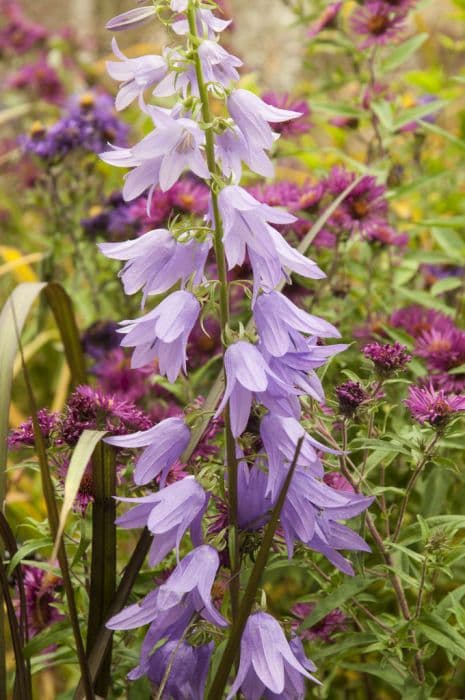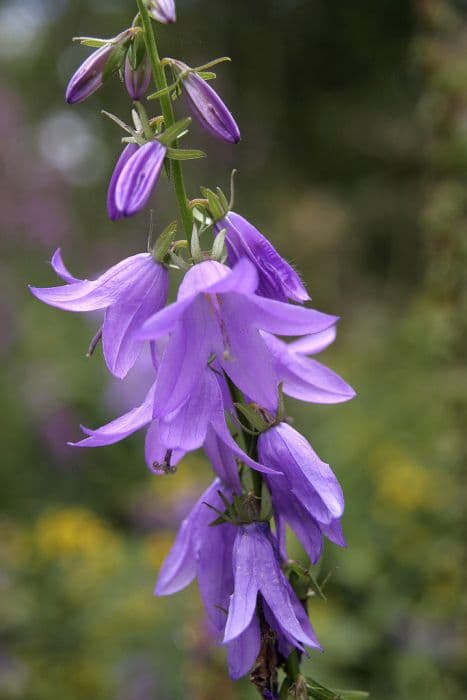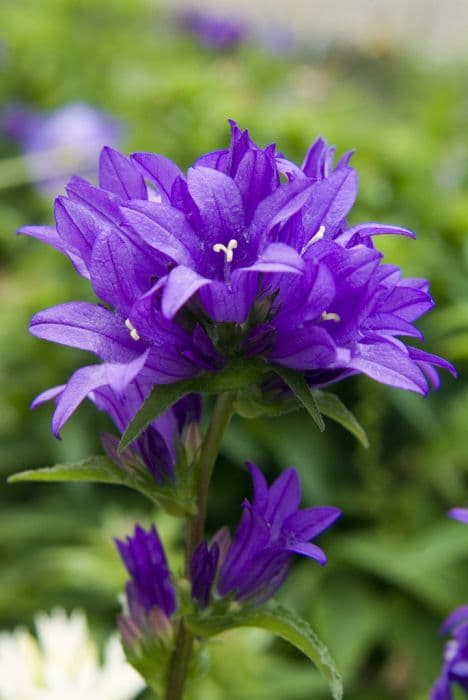Balloon flower Platycodon grandiflorus

ABOUT
P. grandiflorus is a compact herbaceous perennial to 60cm in height, with blue-green, lance-shaped leaves and large, balloon-like buds opening to wide cup-shaped violet-blue flowers 5cm across
About this plant
 Names
NamesFamily
Campanulaceae.
Synonyms
Balloon Flower, Chinese Bellflower, Japanese Bellflower, Blue Balloon Flower, Platycodon, Balloonflower.
Common names
Campanula glauca Thunb., Campanula grandiflora Jacq., Platycodon autumnale Decne., Platycodon glaucus (Thunb.) Nakai, Platycodon leweri Regel, Wahlenbergia grandiflora (Jacq.) A.DC.
 Characteristics
CharacteristicsLife cycle
Perennials
Foliage type
Deciduous
Color of leaves
Green
Flower color
Varies
Height
1-2 feet (30-60 cm)
Spread
1 foot (30 cm)
Plant type
Herb
Hardiness zones
3-8
Native area
East Asia
Benefits
 General Benefits
General Benefits- Ornamental Value - Balloon flower is known for its unique balloon-shaped buds that open into beautiful, bell-shaped flowers, adding aesthetic appeal to gardens.
- Attracts Pollinators - The vibrant flowers attract bees, butterflies, and other beneficial pollinators, supporting local ecosystems.
- Low Maintenance - Once established, balloon flower is a low-maintenance plant that requires minimal care, making it ideal for busy gardeners.
- Drought Tolerance - Balloon flower is relatively drought-tolerant, making it suitable for gardens in dryer climates or for water-wise gardening practices.
- Cold Hardy - It is capable of withstanding colder temperatures, which makes it a good choice for gardens in cooler regions.
- Edible Parts - The roots of balloon flower, known as "doraji", are edible and used in Korean cuisine, although this borders on a medical benefit as they are also used for health purposes.
- Long Blooming Period - It has a long flowering period that typically lasts from summer to early fall, providing long-lasting color to gardens.
 Medical Properties
Medical Properties- Anti-inflammatory: Platycodon grandiflorus has been traditionally used to reduce inflammation.
- Antitussive: It is known to have compounds that may help in alleviating cough.
- Expectorant: The plant has been used to facilitate the loosening of phlegm from the respiratory tract.
- Immune system booster: Some components in Platycodon grandiflorus are believed to enhance immune system function.
- Antioxidant: Offers protection against damage by free radicals due to its antioxidant properties.
- Anti-obesity: Preliminary studies suggest the plant may have potential benefits in weight management.
- Cholesterol-lowering: There is some evidence to support the plant's role in reducing cholesterol levels.
- Anti-diabetic: Research indicates potential blood glucose-lowering effects of Platycodon grandiflorus.
- Anticancer: Compounds in the plant have shown potential anticancer effects in some laboratory studies.
- Lipid metabolism regulation: May have an influence on lipid metabolism, according to some research.
 Air-purifying Qualities
Air-purifying QualitiesThis plant is not specifically known for air purifying qualities.
 Other Uses
Other Uses- Ornamental gardening: Balloon flower is widely used for ornamental purposes in gardens due to its colorful and unique balloon-like buds that open into star-shaped flowers.
- Floral arrangements: The striking flowers of the balloon flower make it a sought-after choice for fresh and dried floral arrangements.
- Culinary garnish: In some cultures, balloon flower petals are used to add a colorful garnish to salads and dishes.
- Edible flowers: The petals of balloon flower, with a slightly sweet taste, can be consumed raw and are sometimes incorporated into salads or used as an edible decoration on cakes and desserts.
- Bioindicator: In ecological studies, the presence and health of balloon flower populations may indicate the status of an ecosystem, as some species react sensitively to environmental changes.
- Ink production: Historically, the root of the balloon flower, due to its rich pigmentation, might have been used as a natural dye for inks.
- Children's education: The unique inflating buds of the balloon flower can serve as an educational example of plant growth and morphology for children.
- Photography: Because of its distinctive appearance, the balloon flower often serves as a subject for nature photographers looking to capture the beauty of unique floral forms.
- Natural fencing: When grown densely, balloon flowers can form low natural barriers or borders within garden spaces.
- Companion planting: Balloon flowers could be used in companion planting schemes to attract beneficial insects that aid in the pollination of neighboring plants.
Interesting Facts
 Feng Shui
Feng ShuiThe Balloon Flower is not used in Feng Shui practice.
 Zodiac Sign Compitability
Zodiac Sign CompitabilityThe Balloon Flower is not used in astrology practice.
 Plant Symbolism
Plant Symbolism- Enduring Love and Affection: The balloon flower, Platycodon grandiflorus, symbolizes unchanging love, due to its hardy nature and long-lasting flowers.
- Perseverance and Determination: It represents the ability to overcome obstacles and challenges, reflecting its growth pattern of breaking through tough ground.
- Friendship: The way the flower blooms from a puffy, balloon-like bud signifies the blossoming of a friendship.
- Openness and Honesty: Its broad, open flowers symbolize an open heart and transparency in feelings.
 Water
WaterThe Balloon Flower, or Platycodon grandiflorus, prefers moderate watering and well-drained soil. It is essential to let the top inch of soil dry out before watering again to prevent root rot. Generally, watering once a week with about one gallon of water per plant should be sufficient. During the hot summer months, you may need to increase the frequency to twice a week, whereas, in cooler seasons or when the plant is not actively growing, watering can be reduced. Always check the soil moisture level before watering to ensure the plant does not become overwatered.
 Light
LightBalloon Flower thrives in full sun to partial shade. The ideal spot for this plant is where it can receive at least six to eight hours of sunlight daily, but it can also tolerate light shade in the afternoon, especially in hotter regions. Avoid placing it in deep shade, as this could lead to leggy growth and reduced flowering.
 Temperature
TemperatureThe Balloon Flower fares well in a range of temperature conditions but prefers a temperate climate. It can survive minimum temperatures down to about 20 degrees Fahrenheit but thrives best in temperatures between 60 and 75 degrees Fahrenheit during the growing season. Extreme heat or cold can cause stress to the plant, so it's important to protect it from temperatures outside of this range if possible.
 Pruning
PruningThe Balloon Flower benefits from occasional pruning to maintain its shape and promote more vigorous growth. Pruning should be done in spring before new growth starts, cutting back any dead or damaged stems to the base. Pinching back the stem tips in early summer can encourage bushier growth and more blooms. This plant doesn't require frequent pruning, so once or twice a year is typically enough.
 Cleaning
CleaningAs needed
 Soil
SoilBalloon flower thrives in well-draining soil with a pH of 5.5 to 7.5. A mix of loamy soil, peat moss, and perlite or sand promotes good drainage and aeration. Amend with compost to supply nutrients.
 Repotting
RepottingBalloon flowers do not require frequent repotting and can be repotted every 2-3 years or when rootbound. Care during repotting is crucial due to their delicate root system.
 Humidity & Misting
Humidity & MistingBalloon flowers prefer average humidity levels and can adapt to the natural humidity found in most homes, without the need for any special adjustments.
 Suitable locations
Suitable locationsIndoor
Place in bright indirect light, avoid overwatering.
Outdoor
Full sun or partial shade, protect from strong winds.
Hardiness zone
3-9 USDA
 Life cycle
Life cycleBalloon flower (Platycodon grandiflorus) starts its life cycle when the seeds are sown in well-draining soil, preferably in spring after the threat of frost has passed. It undergoes germination, usually within a week or two, depending on conditions such as temperature and moisture. Seedlings emerge and gradually develop into young plants, forming a rosette of leaves at the soil level. As the plant matures, stems elongate, and foliage grows, leading to the development of distinctive flower buds that swell like balloons, hence the name. These buds eventually open into star-shaped flowers, usually in shades of blue, purple, or white, throughout the summer. After flowering, the plant sets seed in late summer or early autumn, completing its life cycle, and if conditions allow, these seeds may overwinter and germinate the following spring.
 Propogation
PropogationPropogation time
Spring-early summer
Propogation: The most popular method of propagating Balloon Flower, known as Platycodon grandiflorus, is by seed. Sowing can be done in spring after all danger of frost has passed, directly into a well-prepared garden bed or started indoors roughly 6 to 8 weeks before the last expected frost. The seeds should be scattered lightly on the surface of the soil, as they require light for germination, and should not be buried. Lightly pressing them into moist soil and maintaining a temperature of about 70°F (21°C) will help ensure successful germination. Seeds typically germinate in 14 to 21 days, after which they can be thinned out or transplanted to their final growing positions when they have a couple of true leaves and are robust enough to handle.









